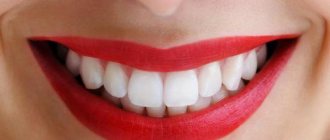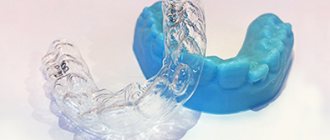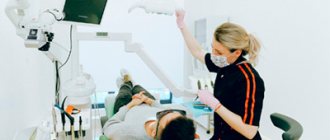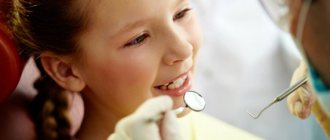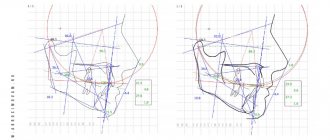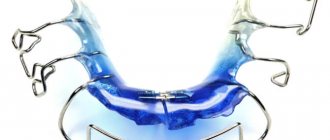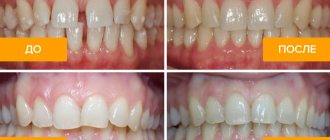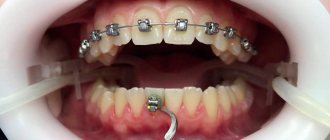What are braces
Braces are a non-removable orthodontic structure for the correction of developmental defects of the dentofacial apparatus. The bracket system consists of two main parts and fastening elements:
- • bracket plates attached using an adhesive composition to tooth enamel; • guiding power arc, which creates mechanical pressure on the teeth; • fasteners: ligatures (rubber rings or metal wire) or miniature locks. If ligatures are used, then the braces are called ligature. If the clasps are ligature-free (self-ligating).
Distal bite: how many years do you wear braces to correct it?
This type of bite is considered one of the most complex and at the same time common dental anomalies. With this type of closure, the upper teeth protrude noticeably above the lower teeth, and the chin appears small relative to other parts of the face. How strongly the distal bite is expressed can be determined by the “sixes” - the sixth teeth in a row. If, when closing, the upper chewing tooth comes into contact only with the “six” on the lower jaw, this indicates a mild degree of violation. If it comes into contact with two teeth of the lower jaw at once, it is severe. It is easiest to treat distal occlusion in childhood and adolescence, when the jaw continues to form and the teeth are more pliable.
Braces for patients with distal occlusion are most often prescribed as part of complex orthodontic treatment, along with methods that change the shape of the jaw. Thus, adolescents may be prescribed a Frenkel apparatus to correct the upper jaw. To speed up the growth of the lower jaw, the orthodontist may recommend wearing a palatal expander, plate or special trainer.
In adults, the jaw is formed; its position can no longer be changed. But you can use braces to slightly correct the position of your teeth. How long you will have to wear braces to correct a distal bite depends on your age and the severity of the problem. On average, the minimum period of wearing braces for such an anomaly is about 1.5-2 years.
Indications for treatment with braces
Like any treatment, indications for orthodontic therapy must be determined by a doctor. Installation of braces is indicated if the following conditions exist:
- malocclusion when the dentofacial apparatus is formed;
- occlusion defects that appear during the period of mixed dentition;
- deviations from the correct growth vector of individual dental elements;
- in preparation for prosthetics (classical or implantation) if tooth extraction causes the remaining elements to shift to the vacant space;
- crowding or, on the contrary, gaps between teeth (diastemas and trema);
- tilting the dental elements forward or backward;
- micrognathia (reduced jaw size).
Sometimes the disorders are clearly expressed, but often only a specialist can notice the pathology. Contacting an orthodontist is necessary in order to promptly identify an anomaly in the development of the dental system and eliminate it.
Mesial bite: how long does it take to correct?
With such an anomaly in the closure of the teeth, the lower jaw protrudes forward, and the teeth of the lower row overlap the teeth of the upper one. Mesial occlusion significantly affects facial aesthetics. If the incisors of the two jaws do not meet, this can lead to problems with diction, speech and chewing.
It is impossible to slow down the growth of the lower jaw using dental methods. Therefore, with such a violation, the orthodontist most often decides to stimulate the growth and expansion of the upper jaw. To do this, braces are placed on the first molars and permanent incisors.
How long they are worn depends on various factors. For some, bite correction occurs after 1 year, for another patient it takes 2 years.
Contraindications for installing braces
Even if there are indications for orthodontic correction using a brace system, it happens that such therapy may be contraindicated for a particular patient. Prohibitions are divided into relative and absolute. Relative restrictions include those that are temporary, for example, the acute course of a disease.
Relative contraindications:
- periodontal diseases;
- dental diseases (caries, pulpitis, etc.);
- pregnancy;
- bruxism.
Absolute contraindications:
- partial edentia (absence of a large number of teeth);
- oncology;
- osteoporosis and other bone diseases;
- mental illness;
- endocrine diseases;
- HIV AIDS;
- tuberculosis.
Other factors that affect the length of time you wear braces
The type of bite and the severity of the orthodontic defect are not the only factors that determine how long to wear braces. The following points also affect the timing:
- type of orthodontic structure;
- patient's age;
- individual characteristics of the body of a particular patient;
- quality of hygienic care for braces.
Types of bracket systems
In dentistry, bracket systems are usually divided into types depending on the main classifying characteristics: location on the dental rows, material of manufacture, presence of ligatures.
Depending on the place of fixation, braces are:
• vestibular – installed on the outer surface of the dentition; • lingual – attached to the teeth from the tongue side.
Depending on the material of manufacture:
- • metal; • ceramic; • sapphire; • combined.
Depending on the method of fixing the power arc on the bracket plates:
- • ligature, i.e. with fastening by means of ligatures (fastening parts in the form of rubber rings or metal wire); • non-ligating (self-ligating). In this case, the guide arc is fixed with small locks.
Open bite: how long should you wear braces?
With an open bite, a noticeable gap forms between the teeth. As a rule, it is located in the area of the front teeth and greatly affects the aesthetics of the smile. In addition, with an open bite, the patient may have a lisp, the tongue may fall out of the gap, which reduces the quality of life and affects self-esteem.
It is very difficult to treat open bites on permanent teeth, so the best option is to see an orthodontist in childhood. There are two main methods of treatment - with braces and with surgery. Sometimes doctors combine both methods: first, they correct the position of the teeth using a braces system, and then perform surgery on the jaws. The recommended period for wearing braces to correct an open bite is 2 years or longer.
Treatment algorithm
Therapy with braces is carried out in compliance with a specific protocol. Let's look at it step by step:
- diagnostics – identifying indications and contraindications, conducting hardware research to determine the complexity and characteristics of a specific clinical case. Performing an orthopantomogram (panoramic image), teleroentgenogram (x-ray image from a remote distance), as well as images in frontal, lateral and axial projection;
- taking dental impressions;
- drawing up a treatment plan;
- preparation for treatment - elimination of caries and inflammation of the oral cavity, professional teeth cleaning to remove soft plaque and hard deposits;
- fixing the finished brace system in the patient’s mouth;
- process of therapeutic influence (movement of dental elements). The duration of therapy depends on the individual and may last up to 24 months or longer. During treatment, the patient should regularly visit the orthodontist to adjust the position of the power guide arc;
- removal of braces upon achievement of results;
- wearing retention devices to consolidate the correction result. The duration of this stage is determined by the attending physician.
How long does it take to wear braces depending on age?
To understand how long to wear braces, you need to take into account the age of the patient. Modern dental technologies make it possible to correct the bite at any age, but the duration of treatment increases in direct proportion to the number of years. A problem that can be corrected in a child in six months will take several years for a mature person to correct. The best age for installing braces is considered to be adolescence - from 12 to 17 years. At this time, malocclusions are corrected as quickly and easily as possible, which can be explained by physiological characteristics:
- Although the dental system in adolescents is already fully formed, it remains quite mobile and “flexible” for some time, therefore, with the help of proper orthodontic treatment, it is possible to move teeth and change the position and shape of the jaw bones.
- During adolescence, muscles and ligaments, which also play an important role in occlusion, remain highly mobile.
Typically, braces are placed on teenagers after the second molars have erupted and when the baby teeth are completely replaced by permanent teeth. At a young age, bone tissue, due to its elasticity, quickly responds to mechanical stress. Therefore, teenagers are usually given braces for a year and a half. This time is enough to correct existing malocclusions.
After 24-25 years, metabolism slows down, bones stop growing and developing, tissues lose elasticity. It takes much longer for the teeth and jaw to change their incorrect position under the pressure of braces. Dentists say that the time required for bite correction in adults approximately doubles compared to adolescence. That is, on average you will have to wear braces for 2-3 years. But the exact time is determined by the doctor, based on the goals of a particular patient (aesthetics or functionality), individual characteristics of the jaw structure and other factors.
The influence of other factors on the time of bite correction
Each person's bone tissue, muscles, and joints react differently to the effects of braces. For some, the correction process occurs faster, for others slower. Much depends on the quality of hygienic care for the brace system, on the health of the teeth and oral cavity, and on compliance with the rules of operation of the orthodontic structure.
If a patient violates the doctor’s recommendations, does not brush his teeth thoroughly enough, or does not use special devices for cleaning braces, this can lead to the development of caries and other dental diseases. They require treatment and tend to slow down the orthodontic correction process.
If the braces break due to careless handling or need to be removed for dental treatment, this will disrupt the process of correcting the bite. The longer a person goes without braces (and making a new system to replace a broken one takes time), the stronger the regression. The teeth may return to their original position, and then treatment will need to be started all over again. Accordingly, the period of wearing braces will be reset to zero.
How to put braces on teeth: direct and indirect methods
The next step in working with patients is directly fixing the braces. They do this in one of two ways:
- direct - a classic option used in every dental clinic;
- indirect - a progressive method that is gaining popularity.
A video on installing braces traditionally introduces the direct fixation method:
Direct method of installing braces
The orthodontist glues braces to each tooth one by one, based on a panoramic photograph of the jaw and the calculations made. The work is jewelry, highly precise, requiring care and concentration.
Stages of fixing the bracket system in a direct way:
- Installing an expander into the patient's mouth so that the orthodontist can clearly see and have access to all teeth.
- Fixation of orthodontic rings to the outermost units - “sixes” or “sevens”. The rings will serve as reference points for the entire system.
- Additional cleaning and polishing of tooth enamel to remove the smallest plaque particles.
- Drying the teeth with an air jet and insulating the tongue with a special “plug”.
- Application of components of an adhesive system to the teeth and plates, which, under the influence of ultraviolet radiation, will ensure the strongest fixation of each bracket.
- Cementing the rings on the outer teeth and passing a metal wire through each clasp is activating the braces.
- Removing excess orthodontic arch wire with nippers.
- Freeing the oral cavity from the dilator and tongue-fixing device.
First of all, braces are placed on the upper jaw and only then on the lower jaw. For the convenience of the patient, appointments can be spaced out in time so that there is an opportunity to adapt to wearing braces.
Devices are rarely attached to only one jaw - these are rather exceptional situations than everyday practice.
Indirect method of fixing the bracket system
This algorithm differs from the previous one in that part of the work is carried out outside the patient’s mouth.
In a dental laboratory, a technician uses dental impressions to make a plaster model. On it, the doctor places the locks at precisely calculated points and connects them with a metal arc. Afterwards, the resulting system is transferred to a mouthguard and placed on the corrected dentition. This allows you to fix the entire structure at once - quickly and comfortably for the child.
How to fix an overbite?
Our clinic sees patients of various ages: children from 2-3 years old, adult patients, as well as patients aged 75-80 years. In some cases, treatment is carried out from the moment of birth, for example, with congenital pathology in children. When correcting a bite, each individual case requires an individual course of treatment and the use of devices such as braces and other devices. In certain cases, it is possible to correct a bite without braces; this is made possible thanks to a system of transparent aligners that are almost invisible. In more complex cases, it is impossible to correct the bite without braces and various types of braces are used for treatment. In case of severe pathology, complex treatment together with a maxillofacial surgeon is possible.
| Transparent mouthguard | Sapphire bracket system |
When is the help of an orthodontist needed?
A perfect smile is the dream of many. And there are situations in which banal oral care will not allow you to achieve your goal. It is recommended to contact an orthodontist for professional treatment in the following cases:
- Distal bite, in which the upper jaw is pushed forward. The incisors located below and above do not touch each other. Due to this position of the dental units, the chin visually appears sloping, and the lower lip is reduced.
- An open bite, in which the teeth do not close together - there is a gap between the upper and lower rows.
- Mesal bite. The lower jaw is pushed forward, with the lower incisors overlapping the upper ones. The upper lip sinks and appears small.
- Deep bite. Pathology in which the upper incisors strongly cover the lower ones. As a result of this condition, the patient may complain of difficulty breathing and problems chewing food.
- Diastema – there are wide gaps between the teeth.
- Crowding - the teeth are located on top of each other, there is no distance between them.
- Teeth “stand out” from the general row. As a rule, this is observed in the case of late change of primary teeth.
Consequences of malocclusion
Correcting malocclusion is not just a whim or a pursuit of aesthetics. In reality, malocclusion entails a lot of unpleasant consequences. First of all, crooked teeth change the function of chewing and swallowing, contribute to the uneven distribution of chewing pressure, and impede hygiene, which, over time, leads to the development of caries, periodontitis, periodontal disease, the formation of tartar and early tooth loss. In addition, symptoms such as tooth mobility, increased spaces between teeth, exposure of the neck of the tooth, headaches, crunching, clicking, pain when chewing and opening the mouth may appear.
It is important to know that a person who is deprived of the ability to smile carries within himself undisclosed features of his own individuality.
Why does your bite need to be corrected?
A pathological bite is not only a cosmetic defect, but also a risk factor for overall health.
- Incorrect occlusion (closing of teeth) affects diction, interferes with proper chewing, contributes to rapid wear of enamel, the development of caries, damage to the gums and soft tissues of the mouth.
- Pathologies of occlusion disrupt the functioning of the mandibular joint and lead to changes in the proportions of the facial skeleton.
- If the teeth are not properly closed, the chewing function is disrupted, which leads to the development of various diseases of the gastrointestinal tract. And pathologies of jaw development directly affect the condition of the respiratory system and ENT organs.
- People with malocclusion feel discomfort when communicating, which leads to the formation of various psychological complexes.
You can correct a malocclusion at any age. For this purpose, a wide range of orthodontic equipment is used – removable and non-removable.


